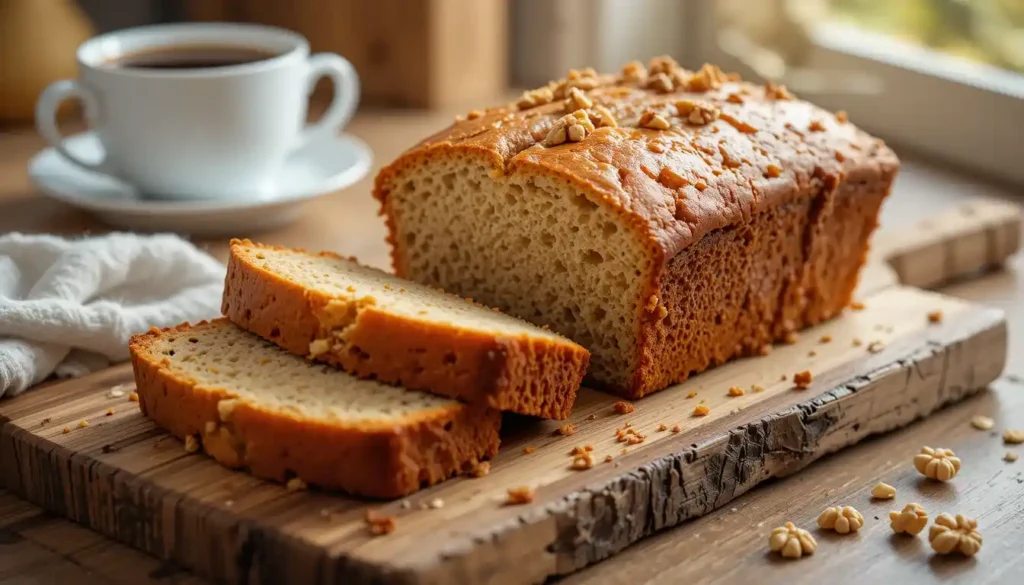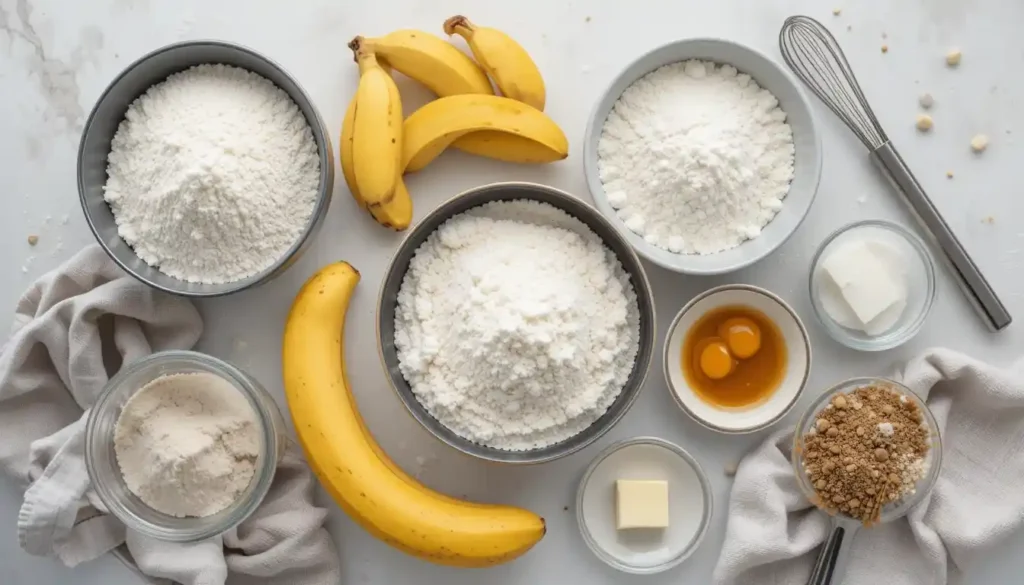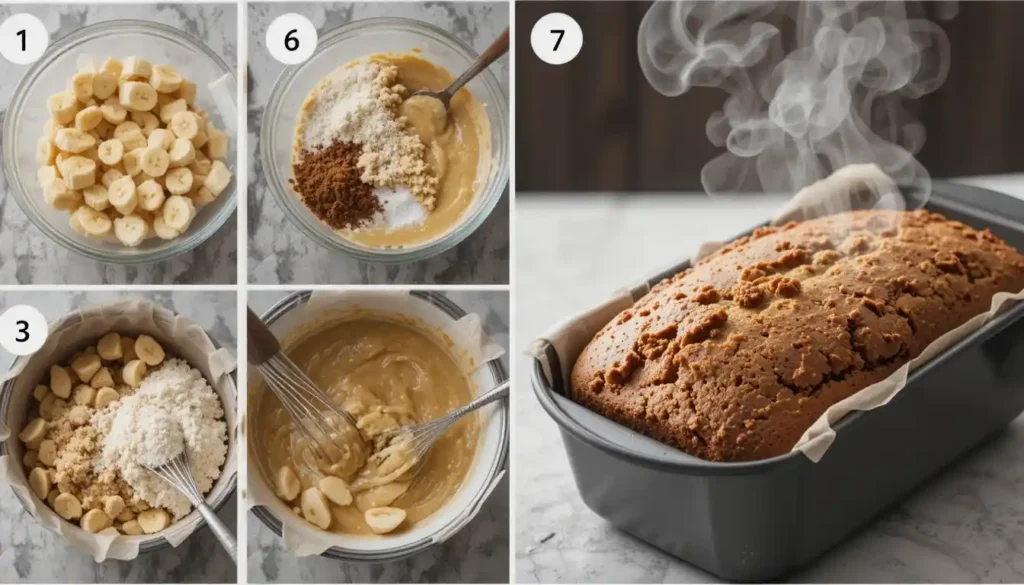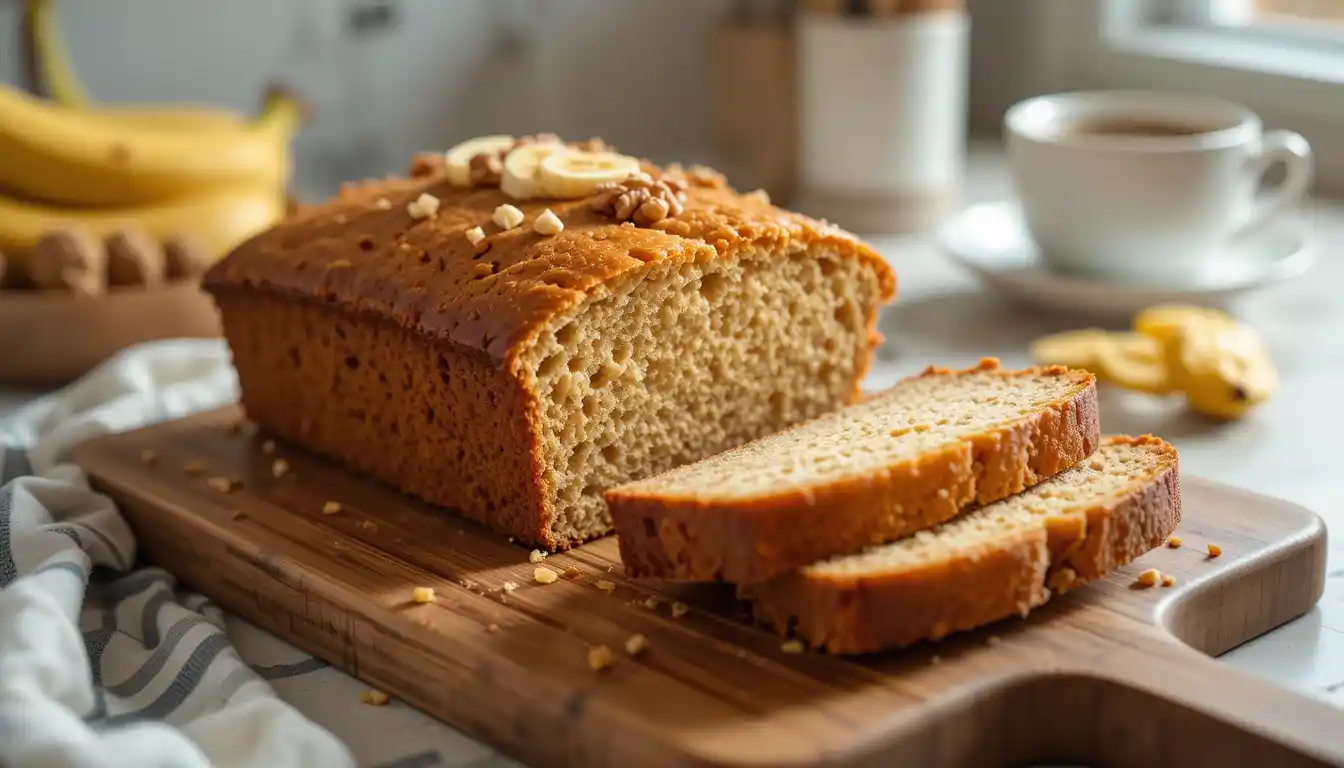Table of Contents
Did you know that overripe bananas are transformed into a mouth-watering delight by home bakers every day? The classic banana bread is a staple in many kitchens, and its simplicity makes it a favorite among bakers of all levels.
You can easily make this moist and flavorful loaf at home using basic ingredients you likely already have. With a few simple steps, you can create a treat that’s not only delicious but also customizable with your favorite add-ins like nuts or chocolate chips.

The Perfect Banana Bread
For over a decade, our banana bread recipe has stood the test of time, captivating bakers with its simplicity and flavor. This beloved banana bread has been the most popular recipe for over 10 years, with thousands making it daily. The secret to its great flavor lies in the use of melted butter, allowing for a moist and tender crumb.
The characteristics of the perfect banana bread include a golden brown exterior and a moist, tender interior. The balance of sweetness from ripe bananas and added sugar creates a signature flavor profile. When sliced, it should hold together while remaining soft and moist.
| Characteristics | Description |
|---|---|
| Exterior | Golden Brown |
| Interior | Moist and Tender Crumb |
| Flavor Profile | Balance of ripe banana sweetness and added sugar |
Our bread recipe is forgiving and adaptable to different preferences and ingredient availability. The ideal loaf boasts a pronounced banana flavor complemented by vanilla and a hint of sweetness. Perfected over many years, this baking recipe yields consistently excellent results, making it simple for beginners yet satisfying for experienced bakers.
Ingredients You’ll Need
Gathering the right ingredients is the first step to baking perfect banana bread. To make a basic banana bread, you’ll need 2-3 very ripe bananas (about 1 1/4 to 1 1/2 cups mashed), 1/3 cup of melted butter, 1/2 teaspoon of baking soda, a pinch of salt, 3/4 cup of sugar (adjustable based on your sweetness preference), 1 large beaten egg, 1 teaspoon of vanilla extract, and 1 1/2 cups of all-purpose flour.

The role of each ingredient is crucial: bananas provide moisture and flavor, flour gives structure, eggs bind the mixture, sugar sweetens, and vanilla adds a hint of flavor. Using room temperature ingredients, especially eggs, ensures they incorporate properly into the batter, resulting in a smooth texture.
It’s also important to note that the quality of your ingredients matters. Fresh eggs, good quality vanilla extract, and accurately measured flour can significantly impact the final product. You can also customize your banana bread with optional add-ins like nuts, chocolate chips, or spices. The ripeness of your bananas can affect the amount of sugar needed; riper bananas require less added sugar. Most of these ingredients are pantry staples, making this recipe accessible to most home bakers, typically measured in a standard cup.
Choosing the Right Bananas
The key to a delicious banana bread lies in selecting the right bananas. For the best results, you should use overripe bananas that are sweeter and more flavorful.
The ideal bananas have yellow peels that are at least half browned, with the bananas inside being squishy and browning. If your bananas are not ripe enough, you can speed up the ripening process by placing them on a baking sheet and baking at 250˚F for 15 to 20 minutes, or by putting them in a paper bag and leaving them at room temperature for 24 hours.
| Ripeness Level | Characteristics | Usage |
|---|---|---|
| Overripe | Yellow peels with brown spots, squishy and browning inside | Ideal for banana bread |
| Green | Hard, green peels | Not suitable, needs ripening |
| Frozen | Previously ripe bananas, now frozen | Excellent for banana bread, often moister |
Using the right bananas ensures your banana bread is sweet and flavorful. Extremely overripe bananas are still usable and often produce the most flavorful bread.
Equipment and Preparation
Before you start baking your banana bread, it’s essential to have the right equipment ready. You’ll need an 8×4-inch loaf pan, mixing bowl, measuring cups and spoons, and a fork or mixer.
- Prepare your pan by buttering it and dusting with flour or lining with parchment paper to prevent sticking.
- Preheat your oven to 350°F (175°C) to ensure even baking.
- Different pan sizes affect the shape and baking time; an 8×4-inch pan yields a tall loaf, while a 9×5-inch pan produces a shorter bread.
Organize your ingredients and workspace before beginning. While a stand mixer can be used, this recipe can easily be made with just a fork and spoon. Arrange your oven racks to the middle position for optimal baking.
Step-by-Step Banana Bread Recipe
To make the perfect banana bread, follow this step-by-step recipe that guides you through mixing, adding ingredients, and baking.

Mixing the Wet Ingredients
Start by preheating your oven to 350°F. In a mixing bowl, mash ripe bananas with a fork until they’re completely smooth. Then, stir the melted butter into the mashed bananas. Mix in the baking soda and salt, followed by the sugar, beaten egg, and vanilla extract.
Adding the Dry Ingredients
Mix in the flour until just combined. Be careful not to overmix. Pour the batter into your prepared loaf pan, making sure to smooth the top.
Baking Your Banana Bread
Bake for 55 to 65 minutes, or until a toothpick inserted into the center comes out clean. To achieve the best results, ensure your oven is at the right temperature and avoid opening the oven door too frequently. The baking time may vary depending on your oven and the size of your loaf pan.
Delicious Variations to Try
Discover the versatility of banana bread with creative variations that tantalize your taste buds. You can experiment with different ingredients to create unique flavor profiles.
Banana Nut Bread
Enhance your banana bread with the crunch of nuts. Walnuts or pecans work well, adding texture and flavor.
Chocolate Chip Banana Bread
Indulge in the richness of chocolate chips in your banana bread. This variation is perfect for those who love a sweet twist.
Creative Flavor Additions
Explore unique flavor combinations by adding spices like cinnamon or nutmeg, or incorporating fruits like blueberries. You can also try adding a drizzle of maple syrup or substituting part of the white sugar with brown sugar for added depth.
Troubleshooting Common Issues
Troubleshooting is an essential part of the baking process, especially when making banana bread. Several common issues can arise, affecting the final product’s quality.
When baking banana bread, you might encounter a few common problems. If the outside of the loaf is browned but the center is still wet, loosely tent the loaf with foil and continue baking until it’s fully baked. A few dry crumbs on the toothpick inserted center are okay; however, streaks of wet batter are not.
Banana bread can sink in the middle due to underbaking or overmixing the batter. To prevent this, ensure your banana bread is baked for the right amount of time and mix the ingredients just until they come together.
Dry or crumbly bread can result from overbaking or using too much flour. To maintain moisture, avoid overmixing and check your bread frequently towards the end of the baking time.
| Issue | Cause | Solution |
|---|---|---|
| Sinking in the middle | Underbaking or overmixing | Adjust baking time and mix ingredients just until combined |
| Dry or crumbly bread | Overbaking or too much flour | Avoid overmixing and check bread frequently near the end of baking time |
| Uneven baking or excessive browning | Incorrect oven temperature or uneven baking sheet | Check oven temperature and rotate the baking sheet halfway through |
To ensure your banana bread is fully baked without overbaking, check it frequently towards the end of the recommended baking time. A toothpick inserted center that comes out with a few dry crumbs indicates it’s done. For uneven baking or excessive browning on top, check your oven temperature and consider rotating the baking sheet.
By following these troubleshooting tips, you can address common issues and achieve a perfectly baked loaf of banana bread.
Storage and Freezing Tips
Proper storage ensures your banana bread remains moist and delicious. Wrapped well, it will keep at room temperature for 4 days. For longer storage, refrigerate the loaf up to 5 days, or freeze it.
- Store at room temperature for up to 4 days.
- Refrigerate for up to 5 days.
- Freeze for longer storage.
To freeze, place the banana bread or un-peeled bananas in a freezer-safe bag, removing excess air. Frozen banana bread or bananas can be stored for up to 3 months. Thaw frozen bananas for future banana bread baking.
Healthier Banana Bread Options
Creating a healthier banana bread is achievable by adjusting the ingredients and baking process. You can make several simple substitutions to enhance the nutritional value of your banana bread.
To reduce sugar content, use very ripe bananas, which add natural sweetness, allowing you to cut down on added sugar to as low as 1/2 cup. Replacing sugar with honey or maple syrup is another option, though you’ll need to adjust the liquid content accordingly.
Substituting all-purpose flour with organic whole wheat flour is a great way to increase the fiber content. You can also replace 1 Tbsp of flour with 1 Tbsp of ground flaxseed for added nutrition.
| Ingredient | Healthier Alternative |
|---|---|
| Sugar | Honey, Maple Syrup |
| All-purpose Flour | Organic Whole Wheat Flour |
| Butter | Oil, Plant-based Alternatives |
| Egg | Flax Egg (1 Tbsp flaxseed + 2.5 Tbsp water) |
These substitutions can affect the texture, flavor, and baking time, so some experimentation may be necessary.
Conclusion
The art of baking banana bread is now at your fingertips, thanks to the simple steps outlined. By following this banana bread recipe, you can create a delicious loaf that’s perfect for any occasion. Remember, using ripe bananas is crucial for the best flavor and texture. Feel free to experiment with different variations to suit your taste preferences. Homemade banana bread not only tastes great but also helps reduce food waste. It’s a great gift idea or contribution to gatherings. Try this recipe today and enjoy the process of baking this classic treat!
FAQ
What type of flour is best for making banana bread?
All-purpose flour is the best choice for making loaf due to its neutral flavor and tender crumb. You can also experiment with whole wheat flour for a nuttier flavor.
Can I use ripe bananas that are too soft to eat?
Yes, you can use overripe bananas that are too soft to eat. In fact, they’re perfect for baking, as they’re sweeter and softer than unripe ones.
How do I know when my loaf is done baking?
Check if your loaf is done by inserting a toothpick into the center. If it comes out clean or with a few moist crumbs, it’s ready. If not, bake for a few more minutes and check again.
Can I customize my banana bread with chocolate or nuts?
Absolutely! You can add chocolate chips, chopped nuts, or other mix-ins to create a unique flavor combination. Just be sure to adjust the baking time as needed.
How should I store my freshly baked loaf?
Store your loaf at room temperature in an airtight container or loaf pan covered with plastic wrap. You can also freeze it for up to 3 months and thaw at room temperature when you’re ready.
Can I make banana bread without a mixer?
Yes, you can make banana bread without a mixer. Simply mash the bananas and mix the wet ingredients in a bowl, then combine with the dry ingredients and stir until just combined.


1 thought on “Banana Bread Recipe”
Comments are closed.